Annual Foot Screen
What is an ANNUAL FOOT SCREEN?
Your annual foot screen is a
comprehensive exam in which your doctor and their team update/overhaul your
chart, check your Medicare compliance, and perform simple & basic tests to
the lower extremity as part of her Lower Extremity Amputation Prevention
(LEAP) program.
Who might have an ANNUAL FOOT SCREEN?
Foot Screens should be performed
annually on patients with at least one of these factors:
·
every diabetic patient
·
every patient over 60 years
old
·
current or former smokers
over 50 years old
·
history of foot and/or leg ulcers
·
history of heart attack,
stroke, TIAs, PAD
·
history of vascular surgery,
angioplasty, open heart surgery
·
neuropathy, Hansen’s
disease, spinal trauma, polio, etc.
·
motor loss to the legs,
Why do it?
 It is simple. A comprehensive program follows guidelines
adopted by U.S. Department of Health and Human Services, to dramatically reduce
lower extremity amputations in individuals with a loss of sensation or other
diseases that can cause breakdown in the feet. Foot Screens also helps document qualifying
criteria for medical necessity with Medicare in the treatment and maintenance
of mycotic nails or callus care and diabetic shoes programs.
It is simple. A comprehensive program follows guidelines
adopted by U.S. Department of Health and Human Services, to dramatically reduce
lower extremity amputations in individuals with a loss of sensation or other
diseases that can cause breakdown in the feet. Foot Screens also helps document qualifying
criteria for medical necessity with Medicare in the treatment and maintenance
of mycotic nails or callus care and diabetic shoes programs.
What is involved?
Come to the office prepared
with:
·
Your current and complete medical history (not just
related to your feet or legs)
·
Hospitalization or surgeries
in the past year
·
Current medication list
·
Names of all the other
doctors/specialists treating your feet or legs for wounds, trauma, nails,
or shoes
·
Approximate dates of your Pneumonia,
Influenza and Tetanus vaccinations
·
Any significant changes that
have happened throughout the past year
·
Arrive unrushed and dressed
comfortably
·
Do not smoke for at least two hours prior to the screen
·
If you are diabetic, we need
your current:
o name of the doctor treating your diabetes and date of
last visit
o A1c results & date
o approximate date of your retinal eye exam
Usually, an Ankle-Brachial
Index test will be performed at the same time. This test is simple, reliable,
and safe. The ABI test is usually the first test used to diagnose PAD in patients
who have active symptoms such as leg discomfort, numbness, or non-healing
sores. The ABI is also used to look for
PAD in patients who do not have any symptoms, but are at risk for the disease due
to their risk factors. Studies have
shown that the ABI can identify about 90% of women with asymptomatic PAD.
Risk Factors for Peripheral Arterial Disease
· Cigarette smoking
· Obesity
· Diabetes mellitus
· High blood pressure
· Physical inactivity
· High blood cholesterol
· History of heart attack,
stroke, TIAs, PAD
· History of vascular /open
heart surgery, angioplasty
Signs and Symptoms of PAD
· Painful cramping of leg
muscles during walking
· Burning/aching pain in the
feet and toes while resting
· Toe and foot sores that do
not heal
· Color changes in the skin
· Cooling of the skin in
specific areas of legs or feet
So call your doctor and get your scheduled.
